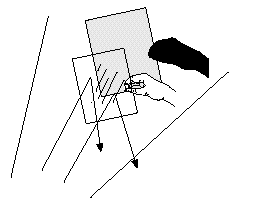Several small sheets of clear glass
or Plexiglass
Emery paper (fine)--Use on glass.
Projector
Screen
Dark room
Procedures:
1. Before handling the glass sheets, smooth sharp edges with emery paper. Skip to the next step if using plexiglass.
2. Hold up one of the sheets so that the students can examine it. Ask them to describe what they see. At some point, one student will say that the glass is clear. Ask the other students if they agree that the glass is clear.
3. Darken the room and turn on the projector.
4. Hold the clear glass between the light and screen. Observe the distinct shadow cast by the edges of the glass and the slight dimness of the light that has passed through the glass. Place an additional sheet of glass on top of the first and observe any difference in the light as it passes through double-thick glass. Add a third sheet of glass and repeat.
5. While holding the glass in the projector beam, observe if there are any reflections of the light around the room.
6. With the room lights back on, observe the edge of the glass. Does light pass through the edge? What color is the edge? What causes this color?

Discussion:
This demonstration provides an analogy for the light-filtering effects of the atmosphere. The shadow cast by the glass shows that although the glass appears to be clear, it prevents some of the light from reaching the screen. The glass reflects some light off its front surface and absorbs some of the light that attempts to pass through it. The effect is similar to what happens with Earth's atmosphere. Part of the visible radiation attempting to reach Earth is reflected by the atmosphere, particularly by clouds, and part is absorbed and scattered by the gases in the atmosphere.
For Further Research:
- Why do the edges of a sheet of glass usually appear green?
- Compare this demonstration with the following activities: Red Sky, Blue Sky? (page 14) and Resonance Rings (page 44).
